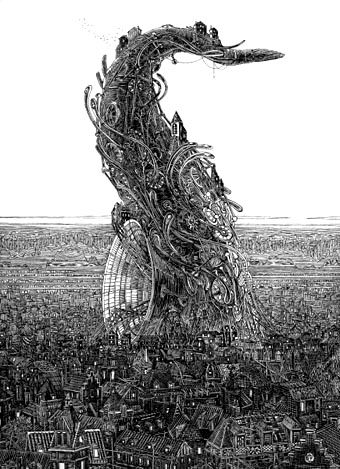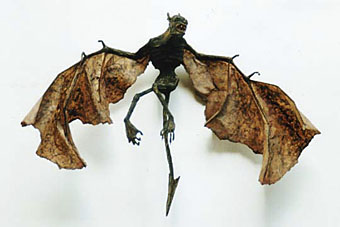Elsewhere on { feuilleton }
• The etching and engraving archive
Category: {fantasy}
Fantasy
The art of Gérard Trignac

Gérard Trignac produces etchings of a kind I’d most likely be doing myself if I wasn’t otherwise occupied, detailed architectural fantasies that owe a lot to my sainted Piranesi and (I’m guessing, since they’re both French) Charles Méryon. As usual with contemporary artists of this nature one can find the pictures but information about the artist is harder to come by. A web search reveals this:
Gérard Trignac was born in 1955, and initially trained to become an architect—training which is evident in his imagined cityscapes. Each of his prints begins with a detailed sketch, which is then fully developed on the copper plate. Each print can take months to complete. Besides individual prints, Trignac has often turned his talents to series of prints used to illustrate classic texts by authors such as Calvino, Borges, and others. His work is in the collection of numerous museums and public collections in Europe and the United States.
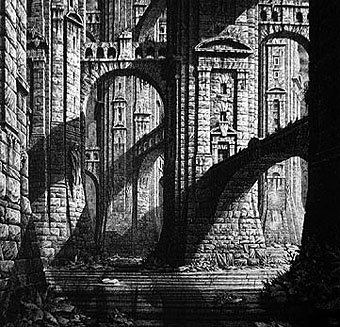
The wonderful (French-only) Egone.net has an artist’s quarter with two Trignac portfolios (scroll to the bottom of the page—and look at some of the other work while you’re there). Work by Gérard’s sister, Colette, is also featured. Other print collections can be found here, here and here.
Elsewhere on { feuilleton }
• The etching and engraving archive
Paris III: Le Grande Répertoire–Machines de Spectacle
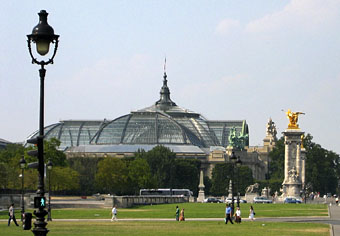
The Grand Palais from Ave du M Gallieni.
The Grand Palais, opposite the Petit-Palais, was built in 1897–1900 by Louvet, Deglane, and Thomas. Its dimensions, covering all area of about 38,000 sq. yds, are imposing. It consists of a large front building, united with a smaller one in the rear by a transverse gallery. The style is composite, but mainly reminiscent of the 17th century. The façade is adorned with a double colonnade, rising to a height of two stories; and there are three monumental entrances in the central pavilion. The sculptures of the central portico, representing the Beauty of Nature, and Minerva and Peace, are by Gasq, Boucher, Verlet, and Lombard. Those to the right represent Sculpture, Painting, Architecture, and Music, and are by Cordonnier, Lefebvre, Carlès, and Labatut. To the left are the Arts of Cambodia, Egypt, Greece, and Rome, by Bareau, Suchet, Béguine, and Clausade. On and under the colonnades are friezes of Amoretti, holding the attributes of the arts. At the top are a balustrade, allegorical groups on the abutments, by Sepsses and Greber, and bronze quadrigae, by Récipon. In the middle of the principal building rises a depressed dome. The rear-façade, in the Ave d’Antin, is embellished with colonnades, sculpture, and friezes in polychrome stoneware, made at Sèvres (Ancient and Modern Art).
In 1900 this building is to be used for contemporary and centennial exhibitions. Afterwards it is to be the scene of the annual exhibitions of paintings and sculptures, horse shows, agricultural fairs, and the like. Its destination explains the peculiarities of its internal construction. The roof is glazed, consisting of curved sheets of glass 10 ft. long and 3 ft. wide.
Baedeker’s Paris (1900).
One of the highlights of this trip was a visit to the wonderful Grand Palais to see an exhibition of invented machines that wouldn’t have been out of place in La Cité des Enfants Perdus or a Terry Gilliam film. The slightly run-down but still splendid venue was the perfect setting for rusted contraptions devoted to making loud noises or smashing things to pieces. The exhibition is still running should you have the good fortune to be in Paris up to the 13th of this month.
Continue reading “Paris III: Le Grande Répertoire–Machines de Spectacle”
The Museum of Fantastic Specimens
Hajime Emoto creates very convincing imaginary creatures, all with a slightly desiccated appearance, that range from the strikingly demonic (like the example above) to more mundane fish, amphibians and plant life. Site is Japanese-only but that don’t let that prevent you from browsing.
Via The Nonist.
Elsewhere on { feuilleton }
• The fantastic art archive
Davy Jones
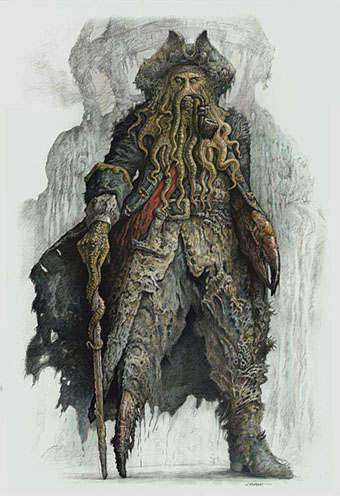
No, not the dreadful singer from The Monkees but he of the undersea locker and also the new villain in Pirates of the Caribbean: Dead Man’s Chest. Bill Nighy plays this splendidly-designed character, with the assistance of some CGI to get those tentacles working. I’ve still not seen the first film but the look of this makes me more interested in the series as a whole.
Aside from William Hope Hodgson‘s sea tales, the pirates plus voodoo/Sargasso Sea angle has rarely been exploited properly in fiction. Tim Powers had a go in On Stranger Tides but the results fell rather flat. In film there’s been hardly anything apart from the Hammer oddity The Lost Continent (1968), based on Uncharted Seas, a Dennis Wheatley potboiler that plundered Hodgson’s Sargasso Sea stories. The new Pirates film may be about to amend this situation; Davy Jones looks like something dreamed up after a heavy diet of Hodgson and HP Lovecraft.

